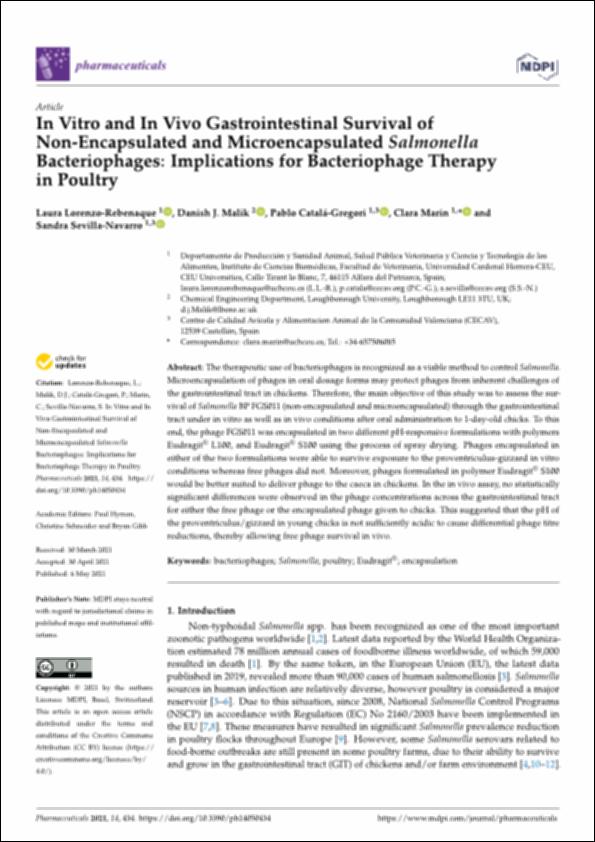Please use this identifier to cite or link to this item:
http://hdl.handle.net/10637/13976In vitro and in vivo gastrointestinal survival of non-encapsulated and microencapsulated "Salmonella" bacteriophages : implications for bacteriophage therapy in poultry
| Title: | In vitro and in vivo gastrointestinal survival of non-encapsulated and microencapsulated "Salmonella" bacteriophages : implications for bacteriophage therapy in poultry |
| Authors : | Lorenzo Rebenaque, Laura Malik, Danish J. Catalá Gregori, Pablo Marín Orenga, Clara Sevilla Navarro, Sandra |
| Keywords: | Aves de corral - Enfermedades.; Poultry - Diseases.; Bacteriófagos - Uso terapéutico.; Salmonella - Control.; Chickens - Diseases.; Pollos - Enfermedades.; Bacteriophages - Therapeutic use. |
| Publisher: | MDPI |
| Citation: | Lorenzo-Rebenaque, L., Malik, D.J., Catalá-Gregori, P., Marin, C. & Sevilla-Navarro, S. (2021). In vitro and in vivo gastrointestinal survival of non-encapsulated and microencapsulated "Salmonella" bacteriophages: implications for bacteriophage therapy in poultry. Pharmaceuticals, vol. 14, i. 5 (06 may.), art. 434. DOI: https://doi.org/10.3390/ph14050434 |
| Abstract: | The therapeutic use of bacteriophages is recognized as a viable method to control Salmonella. Microencapsulation of phages in oral dosage forms may protect phages from inherent challenges of the gastrointestinal tract in chickens. Therefore, the main objective of this study was to assess the survival of Salmonella BP FGS011 (non-encapsulated and microencapsulated) through the gastrointestinal tract under in vitro as well as in vivo conditions after oral administration to 1-day-old chicks. To this end, the phage FGS011 was encapsulated in two different pH-responsive formulations with polymers Eudragit® L100, and Eudragit® S100 using the process of spray drying. Phages encapsulated in either of the two formulations were able to survive exposure to the proventriculus-gizzard in vitro conditions whereas free phages did not. Moreover, phages formulated in polymer Eudragit® S100 would be better suited to deliver phage to the caeca in chickens. In the in vivo assay, no statistically significant differences were observed in the phage concentrations across the gastrointestinal tract for either the free phage or the encapsulated phage given to chicks. This suggested that the pH of the proventriculus/gizzard in young chicks is not sufficiently acidic to cause differential phage titre reductions, thereby allowing free phage survival in vivo. |
| Description: | Este artículo se encuentra disponible en la siguiente URL: https://www.mdpi.com/1424-8247/14/5/434 Este artículo pertenece al número especial "Bacteriophages as Therapeutic Delivery Vehicles". |
| URI: | http://hdl.handle.net/10637/13976 |
| Rights : | http://creativecommons.org/licenses/by/4.0/deed.es |
| ISSN: | 1424-8247 (Electrónico) |
| Issue Date: | 6-May-2021 |
| Center : | Universidad Cardenal Herrera-CEU |
| Appears in Collections: | Dpto. Producción y Sanidad Animal, Salud Pública Veterinaria y Ciencia y Tecnología de los Alimentos |
Items in DSpace are protected by copyright, with all rights reserved, unless otherwise indicated.


